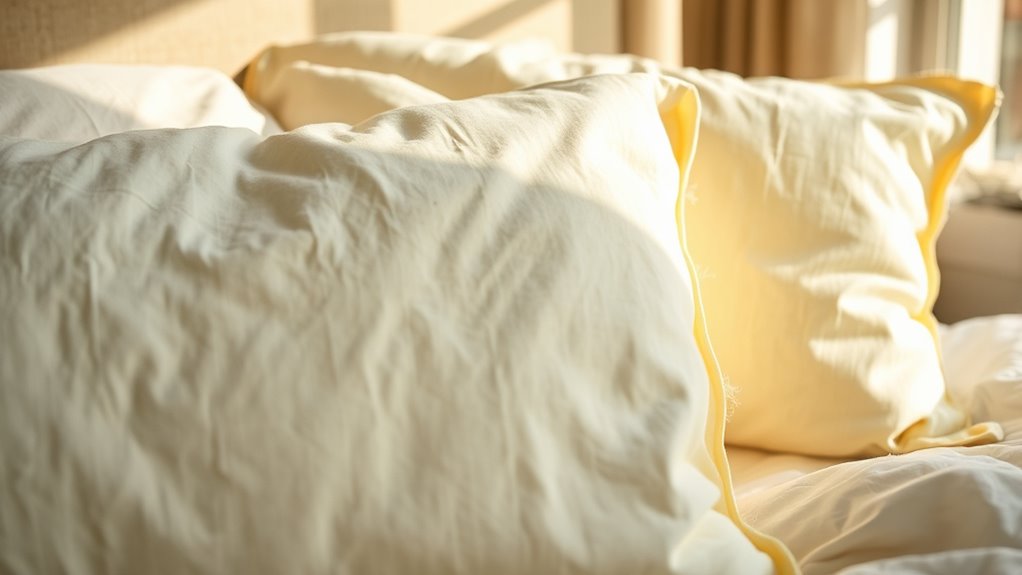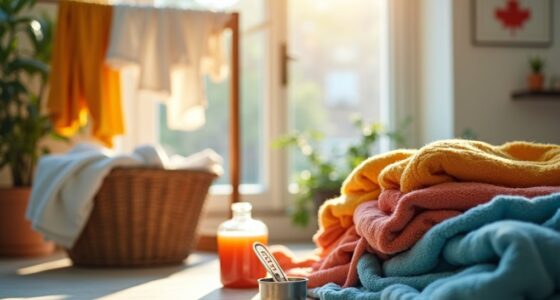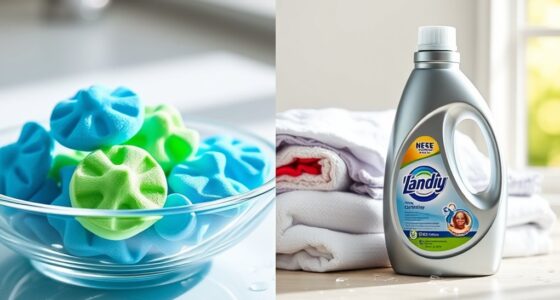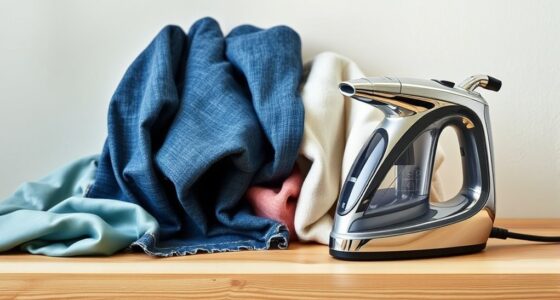To whiten yellowed pillows at home, start by checking the care label and using a gentle method suited to your fabric. You can make a paste with baking soda and water or soak your pillow in a mix of hydrogen peroxide and cold water overnight for effective stain removal. Sun-drying also helps brighten them naturally. For additional tips and step-by-step guides, keep exploring ways to restore your pillows’ freshness and brightness.
Key Takeaways
- Use natural remedies like baking soda paste or hydrogen peroxide soak to lift stains and brighten fabric.
- Sun-dry pillows to naturally bleach and disinfect, enhancing whiteness.
- Always check and follow care labels to choose suitable cleaning methods for fabric types.
- Regularly wash and maintain pillows every few months to prevent deep yellowing.
- Incorporate air purifiers to reduce airborne particles that cause discoloration over time.

Over time, yellowed pillows can make your sleeping space look dull and uninviting. That stubborn discoloration often results from sweat, oils, and dirt accumulating in the fabric over months or even years. Fortunately, you don’t need to buy new pillows to restore their brightness. With a little effort and some natural remedies, you can effectively whiten your pillows right at home. The key is understanding pillow fabric types because different materials require different cleaning approaches. For example, cotton and polyester are common and generally durable, making them suitable for most whitening methods. However, delicate fabrics like silk or wool need gentler treatments to avoid damage. Always check the care label before starting any cleaning process.
When tackling yellowing, natural whitening remedies are a safe and eco-friendly option. Baking soda, hydrogen peroxide, and lemon juice are popular choices because they whiten without harsh chemicals. For cotton or polyester pillows, you can create a simple whitening paste by mixing baking soda with water. Apply this paste to the pillow surface, gently scrub with a soft brush, and let it sit for about 30 minutes before washing. Alternatively, soaking pillows in a solution of hydrogen peroxide and cold water can lift stains and brighten fabric. Mix equal parts of hydrogen peroxide and water, then submerge the pillow for several hours or overnight. Lemon juice can also boost whitening—add a cup of fresh lemon juice to your washing cycle or soak pillows in a lemon-water solution for a few hours. These remedies are effective because they break down stains and neutralize yellow pigments naturally. Additionally, using a HEPA filter air purifier in your home can help reduce airborne particles that contribute to fabric discoloration over time.
To maximize results, always wash your pillows thoroughly after applying any whitening treatment. Use a gentle cycle with warm water, if suitable for your pillow’s fabric, and add a mild detergent. Dry pillows under the sun if possible—sunlight naturally bleaches and disinfects fabrics, enhancing the whitening process. If sun-drying isn’t an option, tumble dry on a low heat setting to prevent damage. Remember, regular maintenance helps prevent yellowing from becoming severe; washing pillows every few months with natural whiteners keeps them fresh and bright longer.
Frequently Asked Questions
Can Natural Remedies Effectively Whiten Yellowed Pillows?
Natural remedies can effectively whiten yellowed pillows and extend their lifespan. Using ingredients like baking soda, hydrogen peroxide, or vinegar, you can break down stains and remove discoloration without harsh chemicals. These remedies are gentle yet powerful, helping to refresh your pillows and keep them looking clean. Regularly using natural solutions not only improves appearance but also preserves your pillow’s quality, making them last longer and stay comfortable.
How Often Should I Whiten My Yellowed Pillows?
You should whiten your yellowed pillows every 3 to 6 months to maintain freshness and cleanliness. Regular pillow maintenance and laundry tips, like washing with gentle detergents and using natural whitening agents, help prevent yellowing. Incorporate routine checks and timely washes into your pillow care, ensuring they stay bright and comfortable. Consistent maintenance not only extends pillow lifespan but also promotes a healthier sleeping environment.
Are There Specific Pillow Materials That Stain More Easily?
Certain pillow fabrics, like cotton or linen, tend to stain more easily because they’re less stain-resistant, while polyester or microfiber fabrics usually resist stains better. You should be mindful of the fabric when cleaning or choosing pillows, as stain resistance varies. Regular washing can help maintain their appearance, but for stain-prone fabrics, consider using protective covers or stain-repellent sprays to keep them looking fresh longer.
Will Whitening Treatments Damage My Pillow’s Fabric?
Whitening treatments won’t turn your pillow into a fragile skeleton, but they can harm fabric durability if used improperly. Always check your pillow’s fabric type and pillow stuffing before applying any treatment. Some harsh chemicals may weaken delicate fabrics, causing tears or loss of fluffiness. To protect your pillow, opt for gentle whitening methods and follow instructions carefully, ensuring your pillow stays vibrant without sacrificing its structural integrity.
How Do I Prevent Future Yellowing of Pillows?
To prevent future yellowing, choose pillow fabrics like cotton or microfiber that resist stains and allow easy cleaning. Regularly wash your pillows using gentle, bleach-free detergents, and always follow care labels. Use stain prevention tips like pillow protectors and pillowcases, which act as barriers against sweat, oils, and dirt. Keep your pillows dry and avoid exposure to excessive sunlight, which can accelerate yellowing, ensuring they stay fresh and bright longer.
Conclusion
With a simple solution and steady scrubbing, you can restore your yellowed pillows to their original whiteness. Remember, consistency is key—regularly revitalizing and rinsing keeps your pillows pristine. So, don’t delay—dedicate a few minutes to maintain, manage, and mirror that magnificent, immaculate, and white look. Keep your pillows bright, beautiful, and blemish-free by embracing these easy, effective efforts. Brighten your bedding and bask in the bold, brilliant beauty of freshly whitened pillows!









